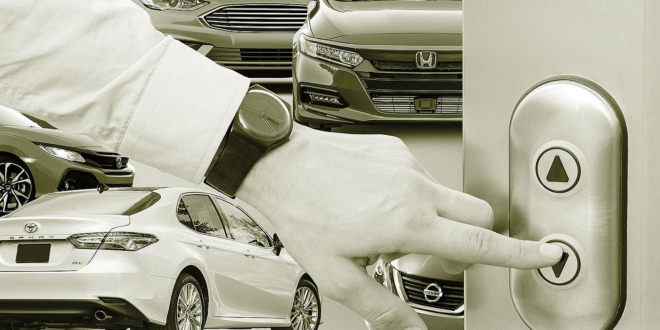
Photo credit: AUTOMOTIVE NEWS ILLUSTRATION
Two-thirds of the way through 2018, U.S. auto sales are up 1.1 percent. But, despite a healthy and growing economy, virtually no one who tracks the industry projects the year to end better than 2017.
That means these next four months are shaping up to be a tough slog to the finish line for automakers — and a test of executives’ ability to suppress their instinct to open up the incentive spigot as dealership traffic fades. August sales declined just 0.2 percent from a year ago, but that was in comparison to a month when Hurricane Harvey decimated vehicle demand in Texas, and the industry’s seasonally adjusted, annualized selling rate fell last month to the lowest level at any point in the past year.

Cox’s Charlie Chesbrough: “The vehicle market likely peaked two years ago.”
“Given all the positive economic news, including a high stock market and low unemployment rates, we might have expected even more, particularly compared to last August which was negatively impacted by Hurricane Harvey,” Charlie Chesbrough, senior economist for Cox Automotive, said in a statement. “This is why we believe all the positive economic news can’t overtake the worsening buying conditions for consumers: The economy may be peaking right now, but the vehicle market likely peaked two years ago.”
Through August, U.S. sales are on pace for a full-year total of 17.4 million. Most analysts predict sales in the final third of the year will taper off and result in a full-year total somewhere between the high 16 millions and last year’s 17.2 million.
The industry is “clearly on the downslope post peak,” Morgan Stanley analyst Adam Jonas said in a note to investors last week. “We’ll need more incentives and higher fleet mix just to stand still.”
Falling all cars
| Percent of car sales of the North American market. | |
| August 2013 | 50.10% |
| August 2014 | 47.60% |
| August 2015 | 43.00% |
| August 2016 | 38.50% |
| August 2017 | 35.50% |
| August 2018 | 28.80% |
But most automakers, pleased by transaction prices that keep rising and well aware of how profit-killing discounts helped spiral the industry into its last downturn, have been loath to throw more cash on the hood, especially on the sedans and other cars that become less popular every month.
Incentives rose just $26 a vehicle, or 0.7 percent, from a year ago in August, according to ALG, while the average transaction price jumped $549.
“Automakers have done a decent job this year at aligning inventory with demand, so there’s no need for dealers to have a fire sale,” Jeremy Acevedo, manager of industry analysis at Edmunds, said in a statement. “Manufacturers seem to be more comfortable with a longer selldown period that leverages targeted incentives, instead of an aggressive ‘everything must go now’ mentality.”
General Motors actually ratcheted down its incentive spending last month, resulting in an estimated 13 percent sales decline, according to the Automotive News Data Center.
Car sales skidded 19 percent in August while light-truck volume rose 10 percent. Cars represented just 28.9 percent of the market last month, a record low for any month.

The Honda Civic, left, and Toyota Camry are top-selling sedans, but both posted double-digit declines in August.
The three top-selling sedans in the U.S. — the Toyota Camry, Honda Civic and Honda Accord — each posted double-digit declines. At Ford Motor Co., which is axing all of its traditional sedans to focus on pickups and utility vehicles, car sales plunged 21 percent.
“It’s tough to forecast where share will finally level out, as consumers have decidedly killed the car,” Zo Rahim, research manager for Cox Automotive, said in a statement. “Our initial idea of the floor being somewhere in the low-30 percent neighborhood appears to be too high in a market that loves its trucks and SUVs.”
Although U.S. employment growth is steady and consumer confidence remains high, trade concerns and rising interest rates loom as wild cards in the remainder of the year.
IHS Markit principal automotive analyst Stephanie Brinley said customers don’t seem to be concerned, although she noted those factors “are expected to push new-vehicle prices upward over time, affecting vehicle affordability.”
David Phillips contributed to this report.
